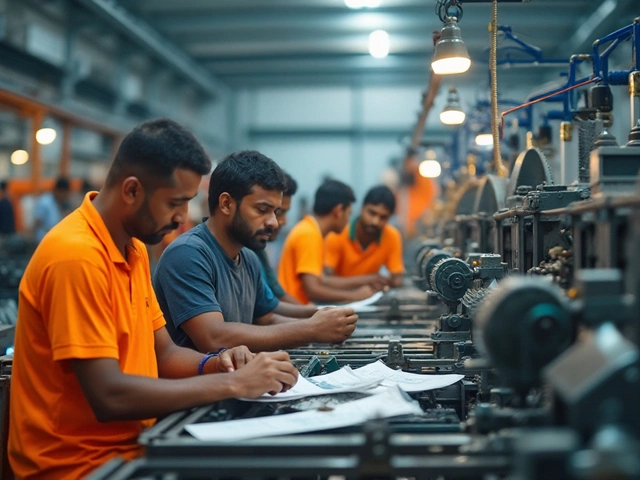Brands: How Names Shape Indian Manufacturing and Beyond
When working with Brands, the names companies use to identify their products, services, or corporate identity. Also known as brand names, they shape consumer perception and market positioning.
Brands work hand‑in‑hand with Manufacturers, entities that actually produce the goods and rely on Suppliers, partners that provide raw materials or components to bring those names to life. Different Industries, like furniture, pharma, textiles, electronics, and steel each have unique branding strategies, but the core idea stays the same: a brand promises something specific, and the supply chain delivers it.
Take the furniture world as an example. IKEA’s iconic flat‑pack designs are instantly recognizable, yet the actual pieces are made by a web of factories across India, China, and Europe. The brand’s promise of affordable, stylish living depends on manufacturers that can hit tight cost targets while maintaining quality. In our post “Who Makes IKEA Furniture? Inside the Global and Indian Supplier Network,” we break down that exact relationship, showing how a strong brand pulls together many moving parts.
Pharma offers another vivid case. Cipla’s brand stands for affordable generic medicines that reach millions across the country. The brand’s credibility hinges on manufacturing plants that meet strict regulatory standards, and on a supplier base that provides high‑purity active ingredients. Our article “What Does Cipla Stand For? Meaning, History & Role in Indian Pharma” maps the brand‑to‑manufacturer‑to‑supplier chain that keeps the medicine flowing.
When you walk into a Surat market, you’ll notice how the city’s brand as "India’s Textile Hub" attracts buyers from around the globe. That identity isn’t just a billboard; it reflects a dense network of mills, dye houses, and logistics providers. The post “Surat: India's Leading City for Textile Industry” dives into how the city’s brand fuels investment, shapes workforce skill development, and drives export growth.
Even material choices carry brand weight. A kitchen set advertised as solid wood carries a different promise than one made from MDF or metal. Our guide “Best Furniture Materials in India: Wood, Metal, MDF & More” shows how brands use material cues to signal durability, luxury, or budget‑friendliness, and how manufacturers must align production processes to meet those expectations.
Why Brands Matter Across Sectors
Across all sectors, a brand is the glue that connects the end‑consumer to the complex chain of production. It influences pricing decisions, determines the level of quality control required, and even guides where factories choose to locate. For instance, the push for “Made in India” branding has sparked a wave of reshoring, as detailed in our piece “Local Manufacturing Explained: Definition, Benefits & Challenges.” Companies are leveraging the patriotism angle to win market share, which in turn forces domestic manufacturers to upgrade capabilities.
Technology‑heavy industries also feel the brand effect. The post “Cheapest Electronics by Country 2025” reveals how brand perception of value can shift buying patterns, prompting manufacturers in low‑cost regions to adopt stricter standards to keep the brand promise alive. Similarly, the steel sector’s heritage brands, like those in Pittsburgh, rely on a reputation built over a century, as explored in “Why Pittsburgh Is Known as the Steel Capital of the United States.” Those legacy brands compel modern plants to balance tradition with innovative production methods.
Every brand, whether it’s a global giant or a regional player, sets a set of expectations that manufacturers and suppliers must meet. This creates a continuous feedback loop: strong brand performance drives investment in better manufacturing, which in turn reinforces the brand’s market position. Our collection illustrates that loop in action, from automotive icons like Tata and Maruti Suzuki to niche sectors like plastic coding (Code 5 Plastic) and semiconductor imports.
Understanding this loop helps you spot opportunities. If you’re looking to launch a new product, ask how the brand will align with existing manufacturers or whether a new supplier partnership could elevate the brand promise. If you’re evaluating a partner’s credibility, check how well their brand reputation matches their production track record. The articles below give concrete examples you can apply right away.
Ready to dive deeper? Below you’ll find a curated set of posts that unpack the interplay between brands, manufacturers, suppliers, and the industries they serve. From the nitty‑gritty of supply chains to the big‑picture branding strategies, each piece adds a layer to the overall picture. Explore the collection to see how a single brand name can drive entire ecosystems forward.

Ever wondered why some top electronics brands are more affordable in Europe than in India? This article dives into real price differences, the reasons behind them, and which brands you should watch out for. From VAT refunds to exclusive EU deals, you'll get tips for smart gadget shopping on your overseas trips. We break down the costs with real examples and insider advice so you can make every rupee count. This is your hands-on guide to hunting high-tech bargains abroad. (Read More)







